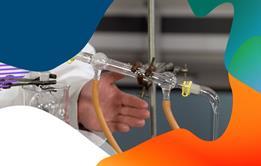Distillation and reflux are techniques used in multiple experiments, but the similarity of set-up can lead to students confusing the two
Distillation is a separation technique that students first encounter in simple experiments such as the separation of brine into salt and water. It can also be used to remove a solvent from a reaction product or to collect a volatile reactant product as the distillate. This video walks a student through a distillation set-up.
Reflux, on the other hand, is not a separation technique. On the contrary, reflux allows you to boil a reaction mixture indefinitely without loss of solvent, reactant or product, as the vapours condense in the condensing tube and trickle back down into the reaction vessel. This enables a chemist to heat a reaction for prolonged periods of time to (a) speed up the rate of reaction, (b) ensure that the reaction goes to completion or a solute completely dissolves, and (c) favour one reactant product over another.
This video from Capilano University walks a student through the reflux apparatus and experimental technique.
The oxidation of ethanol – a required practical for some specifications – combines both reflux and distillation techniques, as well as helping students to understand organic and redox chemistry. Before introducing this experiment, consider asking students to construct equations for the oxidation of ethanol to ethanal and then ethanoic acid, representing the oxidising agent (potassium dichromate) as [O]. This video from Malmesbury Education shows the full experimental procedure, including reflux, distillation and qualitative tests to identify the ethanoic acid distillate.
In the video, Mrs Peers-Dent identifies the acid using Universal Indicator paper and observes effervescence when calcium carbonate is added. Limewater could be used to confirm that the gas evolved is carbon dioxide.
Questions to probe your students’ understanding:
- Why is the potassium dichromate added in excess?
- What would happen if you boiled ethanol with potassium dichromate in an open beaker?
- What would you collect if you boiled ethanol with potassium dichromate without reflux and collected the distillate?
- What you collect if you boiled propan-2-ol with potassium dichromate and collected the distillate?
- What would you collect if you boiled propan-2-ol with potassium dichromate under reflux and then collected the distillate?
- Why is a water bath preferable to a Bunsen burner to heat the reactant vessel containing ethanol?
This further video from ASFC Chemistry provides a summary overview of the differences between distillation and reflux and the chemistry of oxidation for both primary and secondary alcohols.
The reaction between an alcohol and carboxylic acid to form an ester is a further experiment involving reflux and distillation, as well as the separation of aqueous and organic layers using a separating funnel. The following three-part series describes the formation of butyl ethanoate using the correct procedures for heating under reflux, purifying a product using a separating funnel, and carrying out a final distillation. When working with a separating funnel, students might be tempted to shake it vigorously rather than using the more controlled technique of inverting the funnel several times. It’s important to stress that working with glassware requires careful handling to ensure that experiments are conducted safely.
Purifying a product with a separating funnel
This experiment provides an opportunity to also explore related areas of chemistry, such as acid catalysis, equilibrium reactions and ester hydrolysis. Questions you can ask your students:
- How does the sulfuric acid act as a catalyst in the reaction?
- Why is the separating funnel necessary in this procedure?
- How can we use the boiling point of butyl ethanoate to confirm the distillate’s identity?
Also check out…
- Enriching distillation – help students to develop a well-rounded understanding of distillation, its applications across many industries, and the key concepts and models needed to grasp the technique.
- Aspirin – this multi-step synthesis of aspirin will familiarise students with reflux techniques.
Additional information
We have collated these videos of key practical experiments to support remote teaching as part of our response to Covid-19. Teachers requested resources to help them deliver practical content without access to laboratories or equipment. We are developing further resources and welcome feedback to help us produce those you most need. Please email us or use the comment section below.
Practical videos | 16–18 years

Videos of key practical techniques and apparatus for revision, flipped learning or remote teaching
- 1
- 2
- 3
- 4
- 5
- 6
- 7
 Currently
reading
Currently
reading
Reflux and distillation
- 9
- 10
- 11
- 12
- 13











































No comments yet